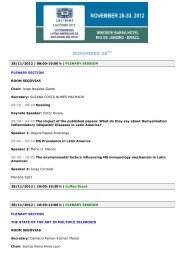Keynote Conference - Interevent
Keynote Conference - Interevent
Keynote Conference - Interevent
Create successful ePaper yourself
Turn your PDF publications into a flip-book with our unique Google optimized e-Paper software.
Symp#17 Glia<br />
Chair Flávia Carvalho Alcântara Gomes<br />
GLAST/EAAT1 induces Glutamine release through SNAT3 in cultured chick cerebellar Bergmann glial cells<br />
Angelina Rodriguez 1 and Arturo Ortega 2<br />
1 Facultad de Química, Universidad Autónoma de Querétaro, Querétaro, Mexico., 2 Departamento de Genética y<br />
Biología Molecular, Cinvestav-IPN, México DF, Mexico.<br />
Glutamate is the main excitatory neurotransmitter in the vertebrate brain. Once released, its extracellular levels are<br />
tightly regulated through the action of a family of sodium-dependent glutamate/aspartate transporters profusely<br />
expressed in glial cells. Once internalized into the glial compartment, it is metabolized by glutamine synthetase to<br />
glutamine and released to the synaptic space through sodium-dependent neutral amino acid carriers of the N System.<br />
Glutamine is then taken up by neurons via System A transporters completing the so-called glutamate/glutamine<br />
shuttle.<br />
Although this neuronal/glial coupling was described decades ago, it has only been recently that the biochemical<br />
framework that supports this shuttle has begun to be elucidated. Using the established model of cultured cerebellar<br />
Bergmann glia cells from chick cerebellum, we characterized the functional and physical coupling of glutamate uptake<br />
and glutamine release. A time-dependent glutamate transporter-induced glutamine release could be demonstrated.<br />
Furthermore, D-aspartate, a specific glutamate transporter ligand, was capable to enhance the coimmunoprecipitation<br />
of the glutamate and glutamine transporters, whereas glutamine tended to reduce this<br />
association. Our results clearly pointout that glial cells that enwrap glutamatergic synapses act as sensors of neuronal<br />
activity and through their contribution to the neurotransmitter recycling, could well the rate-limiting step of<br />
glutamatergic synaptic function.<br />
Understanding Neuron-Glia Interactions: Models Matter<br />
Frank W. Pfrieger<br />
Institute of Cellular and Integrative Neurosciences, CNRS UPR 3212, University of Strasbourg, Strasbourg, France<br />
Brain development and function depend on interactions of neurons and different type of glial cells. Within the last<br />
years, we have developed new experimental approaches that allow to study these interactions in vitro and in vivo,<br />
with a focus on the retina. In my presentation, I will summarize our results, which indicate contributions of astroglial<br />
cells to synapse development, neuronal volume regulation and cholesterol homeostasis in the brain.<br />
Adan Aguirre<br />
Department of Pharmacological Sciences, 442 Center for Molecular Medicine, Stony Brook University, , Stony Brook,<br />
NY 11794-5140<br />
69





